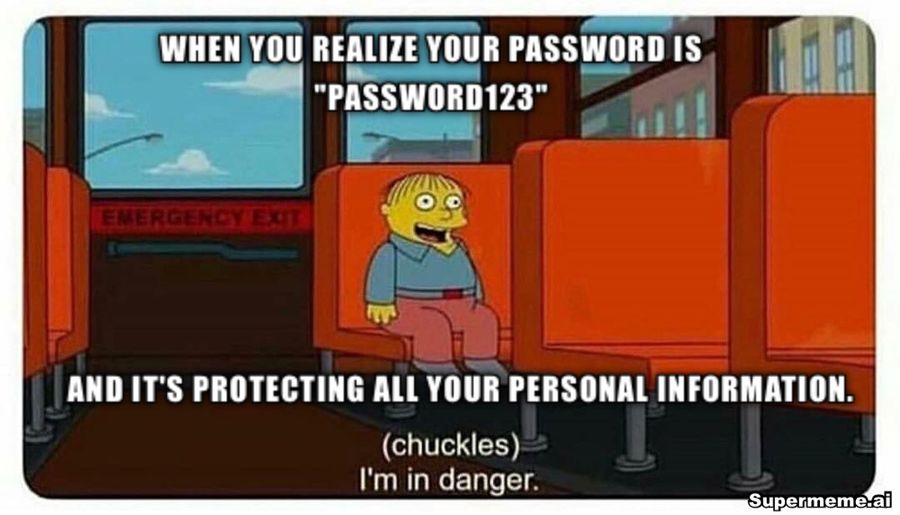The fact that everything you’re personally responsible for, your passwords, is required to secure your cryptocurrency investment scares most would-be investors. Since there’s no legal recourse if anything goes wrong regarding your cryptocurrency security, you want to remember one thing.
Someone once compared blockchain security passwords to underwear. They’re personal (you don’t let others see them), you should change them often (perhaps not daily), and they should be mysterious and maybe sexy.

Since crypto wallet security is your responsibility, this guide will show you how to deter cyber threats and employ an online banking style to protect your crypto investment.
Introduction to Cryptocurrency Security
The dizzying rise of cryptocurrencies in a few years – from a digital novelty to a trillion-dollar technology – has created challenges for individuals, governments, and central banks. A technology once dismissed as a figment of the imagination of tech evangelists has skyrocketed to mainstream popularity and shown the potential to disrupt traditional financial systems. Besides being used as an alternative currency to buy real estate, software, and other goods and services, uncountable individuals and organizations already hold crypto as an investment with trillion-dollar valuations.

Have you ever asked yourself why you’re always advised to include letters, numbers, sign language, doodles, and some queer squirrel noises with your crypto password best practices? That’s because the digital realm is a den for cybercriminals, prowling to identify the minutest security vulnerability they can exploit. Whether you’re an individual or a business navigating the crypto sphere, you must deliberately implement military-grade security measures to protect your digital assets, representing a portion of your wealth, which criminals can siphon instantly.
Common Cyber Threats in the Cryptocurrency Landscape
Cyber threats are attempts by hackers or digital adversaries to access your computer network or cryptocurrency wallet to alter, destroy, steal, or expose your passwords. Suppose you spend more thought, time, and resources on your coffee or data than cybersecurity. In that case, there’s every chance that you’ll get hacked because cybercriminals target a wide range of victims intending to access their sensitive data. Some examples of cyber threats include the following:
Crypto Hacking: Crypto hacking occurs when a hacker gains unauthorized access to an individual’s or cryptocurrency exchange’s cryptocurrency wallet and steals their crypto coins. This happens when individuals fail to implement password best practices or the exchange security gets compromised. An example is a bridge attack where hackers transfer your digital assets from one blockchain to another.
Wallet Theft: A hacker can steal your online or offline cryptocurrency wallet if it’s not adequately secured. Wallets are software applications that facilitate the access, management, and transfer of digital assets, and bad actors can gain access and steal your funds.
Malware: Also known as malicious software, malware refers to a program or code that hackers create with ulterior motives. The most common forms of malware are cyber-attacks comprising subjects like cryptojacking, ransomware, viruses, spyware, worms, Trojans, and keyloggers.
Phishing: Phishing is a cyber-attack that entices an unsuspecting user to share sensitive information like account numbers or passwords via email, social media, SMS, or other social engineering techniques. It also comprises tricking a user into downloading malicious files that install viruses on electronic devices.
Read more: Poly Network Users in Shock: Bridge Exploit Hits 57 Cryptos

Spoofing: Spoofing is when a hacker masquerading as a known or trusted acquaintance. They engage with their victim to access sensitive information, installing malware, or stealing crypto assets through pretentious means.
Code Injection Attacks: Code injection attacks comprise cybercriminals using tricks to inject malicious code into your vulnerable computer or network, ultimately changing its course of action.
Read more: Cryptocurrency 101: A Beginner’s Guide to Understanding Cryptocurrencies, and Their Advantages
Essential Security Measures for Cryptocurrency Holders
According to a Forbes survey, the market caps of Bitcoin, Ethereum, and Tether are 330.6bn, $152.6bn, and $68.2bn, respectively, making crypto traders and their wallets a magnet for hackers. Data from Chainalysis on blockchain security shows that hackers stole over $3.8 billion of cryptocurrency in 2022. In one instance, malicious actors penetrated Wintermute’s hot wallet and stole $162.5 million.
To achieve their target, cybercriminals search, detect and exploit vulnerabilities in private keys. This secure code proves a crypto wallet’s ownership, allowing the holder to initiate and complete transactions. Any malicious actor will access your cryptocurrency wallet if your keys (passwords) are unsafe. Maintaining crypto wallet key integrity is, therefore, a critical factor. The following are proven practices to help protect yourself against cryptocurrency cyber threats:
- Secure Wallets and Storage Solutions
The best way to protect your cryptocurrency is, to begin with a secure wallet, meaning you surpass providers of “ordinary” wallets and choose companies that include security measures. A good example is choosing an encrypted wallet to protect your private keys. Since it takes just a single security vulnerability for a hacker to invade your mobile gadget, tablet, or PC, you want to install a premium antivirus.
It’s crucial to activate firewall settings for maximum security, besides taking advantage of antispyware to check for malicious software. When researching wallet options, it’s necessary to consider cold storage over hot wallets, besides reading user reviews and a provider’s security track record, including how often they conduct security audits.
- Two-Factor Authentication (2FA) and Multi-Signature Wallets
Cryptocurrency wallets do not store your cryptocurrency; they securely store your passwords or private keys that allow you to access and use your digital assets. Securing your password or having their offline backup is necessary so you can have peaceful nights. You want to choose multi-signature wallets that offer some form of two-factor authentication (2FA), meaning any eligible user has to validate pending transactions before they can be approved.
With 2FA, you can detect unauthorized access, halt transactions, and revoke access by malicious actors. The most common type of multisig is 2FA requiring a dual key system where a user authenticates a transaction via a temporary password sent via SMS.
- Strong Password Practices
Keep your hard-earned crypto assets off the hands of crafty hackers, you must remember that they have become crafty over time and can somehow get access to your password. Since hackers can manually guess passwords or use other elaborate email server hacks, you must do everything to ensure no malicious actor gains unwanted access to your account and cryptocurrency. Some things you can do to have a password that can secure your wallet include:
Create a string password: Create a secure password because it’s your first line of defense. Avoid passwords like “123456”, “password,” “qwerty,” or similar that anyone can guess.
Make it long and complex: The longer and more complex a password, the more difficult it is for a hacker to guess. Use random phrases that are easy to remember or hard for anyone to think about.
Don’t use personal information: Never use personal information like addresses, birthdays, anniversaries, or pets’ names. Choose security questions that can’t be found on your social media accounts.
Use alphanumeric characters: Consider using keyboard characters such as numbers, symbols, and lower and uppercase letters that aren’t easy to guess. An ideal password should have at least 12 characters.

- Keeping Software and Firmware Up to Date
Always ensure your software and firmware are up to date since updates patch security flaws, enhance existing features, fix bug issues, add security features, and improve performance. Most device and software manufacturers offer regular updates, which users must keep track of. Minor software updates fix bug issues, while bigger ones can patch emerging security flaws. Make a deliberate effort to update software as and when available, as it protects your device from cyber threats. Failure to accomplish software updates gives hackers backdoor access to your devices and possibly cryptocurrency wallets.
Key Takeaways
The ongoing adoption and popularity of cryptocurrencies as digital assets gain traction means securing storage solutions is paramount. Advancements in secure hardware, privacy-preserving technologies, and cryptography generally mean continuous improvement in blockchain, crypto, and DeFi (decentralized finance) security. Moreover, ongoing research and development efforts are addressing existing vulnerabilities and developing innovative solutions.
As developers play their role, users and investors are responsible for choosing reputable wallet providers, regularly updating their software and firmware, implementing robust authentication methods, and following password best practices. Also, users are encouraged to use decentralized exchanges (DEXs) that facilitate decentralized identity practices where trading happens directly from a user’s wallet.
Using DEXs reduces the need to struggle with trusting centralized exchanges (CEXs), thereby minimizing the risks associated with having your crypto assets on an exchange with the attendant risks. Most importantly, consider offline storage, also known as cold storage, so you can keep your wallet and assets offline when disconnected from the internet. Cold wallets offer an additional layer of cyber security, especially if you’re considering long-term storage for your cryptocurrency.
To Sum Up
Prioritizing wallet security is your key to enjoying a successful crypto journey, and you can only achieve it by adopting and implementing these recommended measures to safeguard your cryptocurrency. Moreover, you want to continue educating yourself on wallet security besides staying vigilant against constantly emerging threats in a crypto sphere that’s always evolving. If you’re a regular user, remember to regularly audit your wallet address and transaction history to flag unauthorized or suspicious activity. Monitor your transactions to detect security breaches early and take appropriate action before it’s too late.
As for passwords, treat them like toothbrushes; they can’t be shared under whatever circumstances.
Disclaimer: All materials on this site are for informational purposes only. None of the material should be interpreted as investment advice.Please note that despite the nature of much of the material created and hosted on this website, HODL.FM is not a financial reference resource and the opinions of authors and other contributors are their own and should not be taken as financial advice. If you require advice of this sort, HODL.FM strongly recommends contacting a qualified industry professional.




